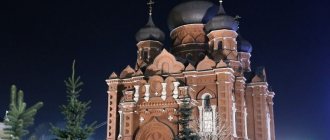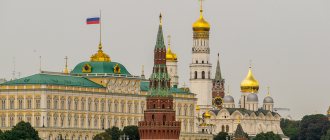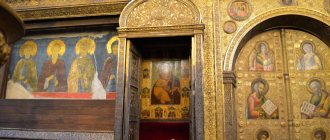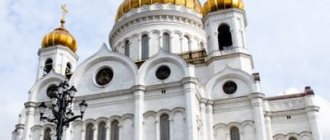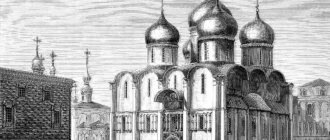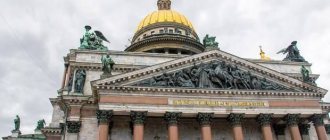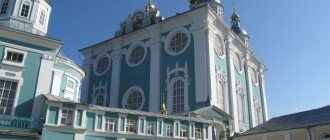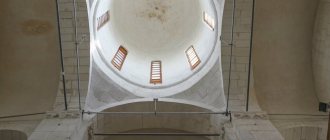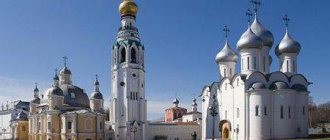The Assumption Cathedral (Cathedral of the Assumption of the Blessed Virgin Mary) is located on the territory of the Kremlin in the city of Astrakhan. The building is considered one of the best examples of Russian architectural art. This is the only existing temple complex that connects the main building and the Execution Place (a place for bishops’ exits and prayer services). Let's dive deeper into the history of the Assumption Cathedral in Astrakhan.
A little history
The origins of Astrakhan go back centuries. The first mention of the place where the city is located today dates back to the thirteenth century. Officially, the date of birth is considered to be 1558, when the construction of a wooden Kremlin began on the left bank of the Volga. It was then, after joining the Russian state, that a new page began in the history of the Astrakhan Khanate. However, the city received its official status later - at the beginning of the eighteenth century, under Peter I.
But historians have other opinions on this matter. Astrakhan local historian Vladimir Gusev believes that Astrakhan is already 1385 years old. The scientist believes that the emergence of the city cannot be dated to any specific year, since it is a long process, expressed in political, economic and cultural development.
Some historians, studying the mythological descriptions of these places, are inclined to believe that the land of Astrakhan is very ancient - it is about seventy thousand years old!
History of the Kremlin
The construction of the Kremlin defensive structure began in the middle of the 16th century according to the design of engineer Vyrodkov with a double wooden fortress wall. Wall openings were filled with earth and large stones. The layout of the fortress fence was in the shape of a right triangle with the apex directed to the southwest. Four years after the start of construction, a tower and entrance gates appeared in the Kremlin.
After the annexation of new lands to the Russian state and access to the Caspian Sea, the importance of the fortress increased. During the reign of Ivan the Terrible, the construction of a stone fortress began, which was completed by Boris Godunov. A complex of fortifications, church and civil buildings grew around the tower.
origin of name
Today there is also no clear version regarding the origin of the city’s name. There are several legends. The first of them is associated with the Aesir tribe that inhabited these regions. Brave warriors, for their courage and honor shown in battles, received from the khan a document that exempted them from duties in favor of the Tarkhan power. In honor of this significant event, the aces named the city As-tarkhan.
There is also an opinion based on data from a written source. In the description of his journey, the Arab subject of Ibn Batuta tells that the city was named after one pious pilgrim. The Turkic hajj, who chose this place for settlement, received it as a reward from the Sultan duty-free, or, as they said then, the Sultan made the pilgrim a Tarkhan. This is where the name Hadji Tarkhan came from. As it developed, the village grew into a village, and then turned into a city.
Traveler Afanasy Nikitin also spoke in support of this name. He visited these places in the mid-fifteenth century and argued that Astrakhan is a Russian version based on Khadzhi Tarkhan.
Astrakhan local historian Vladimir Gusev believes that the first name of the city was Aztargan, and it was founded around 625 by the Western Turkic Kagan Ozbulan.
Modern life
The city of Astrakhan today is a large port center, which is of great strategic importance for the state, since cooperation with many Caspian countries is realized through it. This is one of the powerful industrial centers, which has a developed transport network and a favorable economic and geographical location as its advantages. The Astrakhan region with its highways is included in the global transport system connecting the north and south.
Astrakhan is rich in natural resources, allowing the city to develop various sectors of the economy. Fishing flourishes here. The light and food industries are well developed.
But the cultural and historical component is especially noteworthy. There are many museums and churches here. Among all the churches of such a historical city as Astrakhan, the Assumption Cathedral looks especially majestic. This is one of the main shrines of this region.
Sights of Astrakhan
Considering the long history of this Russian city, one can imagine how many interesting things there are in it. Something has been lost, but, fortunately, much has survived to this day.
One of the most famous attractions around the world is the Astrakhan Kremlin, which can be considered the central monument of the city. This architectural monument, unique in its historical value and beauty, was created over the course of forty years - from 1580 to 1620. He is the embodiment of the military engineering genius of those centuries, as well as a kind of calling card of the city. Situated on the highest hill, it is visible from everywhere.
The territory of the Kremlin covers several other attractions, including the most famous Orthodox church in Astrakhan - the Assumption Cathedral. Here is the bell tower of the Prechistensky Gates - the famous, tallest tower of the city with a height of more than eighty meters. Astrakhan also has its own nature reserve, where you can learn about the true wealth of Astrakhan flora and fauna. There is a circus, many museums, a beautiful and well-kept embankment, fountains and many other interesting places.
Prechistenskaya Bell Tower
The entrance Prechistensky gate stands out against the sky with a snow-white four-tiered bell tower 80 meters high. Built in the first decade of the 18th century, the belfry was rebuilt four times due to the constant tilt caused by subsidence. At the end of the 19th century, the tilt was so obvious that the townspeople called it “the local Leaning Tower of Pisa.”
For the unique bell tower, 1910 became a new birth thanks to the architect Karyagin, who built it in the ancient Russian classical style of architecture. In 1912, the belfry was decorated with electric musical chimes, emitting a melodious chime every 15 minutes, and at 12:00 and 18:00 playing the solemn melody of Mikhail Glinka “Hail”. We still see such a Prechistenskaya bell tower, depicted in photographs of numerous tourist brochures, today.
Astrakhan Kremlin
I would like to say a few more words about this city-forming place. Since 1980, this architectural ensemble has acquired the status of a monument of federal significance.
The Astrakhan Kremlin was created through the efforts of Moscow city planners: Mikhail Velyaminov, Grigory Ovtsyn and the official Dey Gubasty. It is interesting that the plinths remaining from the Tatar ruins were used as building materials.
The exhibitions presented here, united in the historical and architectural complex of the same name, can tell a lot of interesting things about the history of the construction of the Astrakhan Kremlin and the development of the city. Of particular interest are the exhibitions housed in the towers. For example, the Artillery, or torture, tower allows you to get an idea of how punishment was done in those days in Rus'. But this exhibition is open to visitors over sixteen years of age.
The exhibitions of the Red Gate tower tell visitors about the history and development of the Astrakhan Kremlin in different centuries. There is, for example, a photo exhibition called “Old Astrakhan”, where you can see old photographs of the city from the late 19th - early 20th centuries, as well as their reproductions.
A lot of interesting things can be seen on the territory of the Kremlin. Also here is the Trinity Cathedral, the St. Cyril Chapel, the Bishop's House and many other attractions that tell about such an ancient city as Astrakhan.
The Mystery of the Water Gate
During the 1970 reconstruction of the section of the fortress wall from the Nikolskie to the Red Gates, under the thickness of the foundation of a dilapidated former infirmary for soldiers, a secret underground passage was found. The corridor dug underground was lined with brick. The exit to the outside was covered by a heavy metal grate that rose and fell as a mechanical drum rotated. The popular legend about the underground passage to the Volga was confirmed. The hiding place under the mountain was a water gate, which served as the only way out to replenish water supplies during the siege of the fortress.
Assumption Cathedral
It is located on the territory of the Kremlin and is its most famous shrine. Its building rises majestically on the territory of the Kremlin and is visible from anywhere in the city and its environs. The height of the Assumption Cathedral (Astrakhan) places it among the tallest Orthodox cathedrals in Russia and the world. This pearl of Russian Orthodox architecture was created by Dorofey Myakishev.
The temple has a two-tiered structure. On the first level, which is smaller in height, there is the so-called lower temple, the place where the remains of Astrakhan priests are buried. Here are reliquaries with the relics of holy saints and holy martyrs.
The upper temple is tall and bright. Sunlight passes through two tiers of huge windows.
Like the Kremlin, whose history tells the story of the life of such a glorious city as Astrakhan, the Assumption Cathedral is also a landmark with a rich and eventful past.
Architecture and interior decoration of the building
The building was built in the Moscow Baroque style, has a cubic shape and five domed domes. The facade is decorated with shaped bricks and stone carvings. Three semicircular arches are decorated with paintings on a biblical theme.
The cathedral is divided into two levels: the upper and lower church. The upper level is intended for holding services in the summer, the lower level serves as a tomb and “winter temple”.
Upper Church
The upper church is distinguished by an abundance of light and space. Its main attraction is the famous eight-tiered (according to church canons there should be no more than 7 tiers) iconostasis, for which the famous Kazan icon painter Nikifor Popov worked on the icons. Prince Stroganov’s house painter Ivan Andreev was also involved in its creation.
Through the efforts of the merchant-philanthropist Sapozhnikov, 4 massive marble columns, decorated with paintings, and silver royal doors, made by one of the St. Petersburg jewelers, appeared in the upper church. The ceilings of the 5 chapters are also skillfully painted.
Lower Church
The lower temple is devoid of paintings and any decorations. Initially it was intended for the repose of Astrakhan bishops. The walls of the lower level are painted with funerary inscriptions, allowing you to learn about each burial.
The lower church has a small iconostasis. In winter it is heated, and during the cold season, services are held there. Also below are the relics of various saints and great martyrs, access to which is open to everyone.
Chronicle of the cathedral
It begins in 1560, when the first log church was built on this site, which by the end of the century had fallen into disrepair and was replaced by a more durable stone one. However, this building was not destined to stand for long. The reason that served as the reason for the demolition of the stone church was its size, which did not accommodate the rapidly growing parish community.
And in 1699 they began to build the Assumption Cathedral (Astrakhan), the history of its construction lasted for ten years. The first obstacle on this path was the lack of material support from the state. Metropolitan Sampson took control of the construction and turned to the local merchants and landowners for help. The local nobility did not become greedy and collected a sufficient amount, inviting the best craftsmen of Astrakhan to work. Architect Dorofey Myakishev was appointed chief architect of the project.
The first architectural plan envisioned a single-domed temple. However, during construction, problems with its stability were discovered, and the master architect proposed a new five-domed project. And in 1710, services began in the temple.
The revolutionary years made their own amendments to the life of the entire state, and they did not bypass Astrakhan. The Assumption Cathedral was searched many times, and a large number of all church utensils were taken away. A huge part of it was melted down, and the cathedral was closed. Since 1922, it began to be used as a warehouse, gym, shooting range and for other needs.
By 1992, the temple was in terrible condition: the iconostasis was burned, the walls were dilapidated, and the icons were destroyed. This year the restoration of the cathedral begins. Divine services are first held in the lower church, and a few years later they are resumed in the upper one.
Cathedral iconostasis
This is the main decoration that distinguished the Assumption Cathedral (Astrakhan) in pre-revolutionary years. The iconostasis here was unique, as it rose eight tiers. The church traditions of constructing churches in those days did not allow more than seven rows of icons.
Before the revolution, the iconostasis of the Assumption Cathedral was decorated with the most beautiful icons painted by famous masters: Nikifor Popov and Ivan Andreev. Today, most of them have been restored, and it has acquired its eight-tier height.
Guardhouse building
The first guardhouse was built at the beginning of the 18th century during the reign of Peter I. The guardhouse that appears to the eyes of Kremlin visitors today dates back to 1808. It was built on the site of an old guardhouse for the garrison guard. Currently, excursions are being held around the premises of the guardhouse, during which visitors will learn interesting details of the life and service of soldiers in the 19th century, examine the interior of the officer’s living room and the garrison commander’s office, and visit the premises for prisoners.
Where is Astrakhan located?
This amazing ancient Russian city is located in the Southern Federal District of Russia. In addition to the Astrakhan region, it includes five more subjects. The territory of the district is located in the south of the European part of Russia and belongs to the Volga-Caspian region.
Answering the question where Astrakhan is located, it should also be said that it is all located on eleven islands of the Caspian lowland, they are connected to each other by thirty bridges. The bulk of the city's population lives on the left bank of the Volga, and only a fifth lives on the right.
